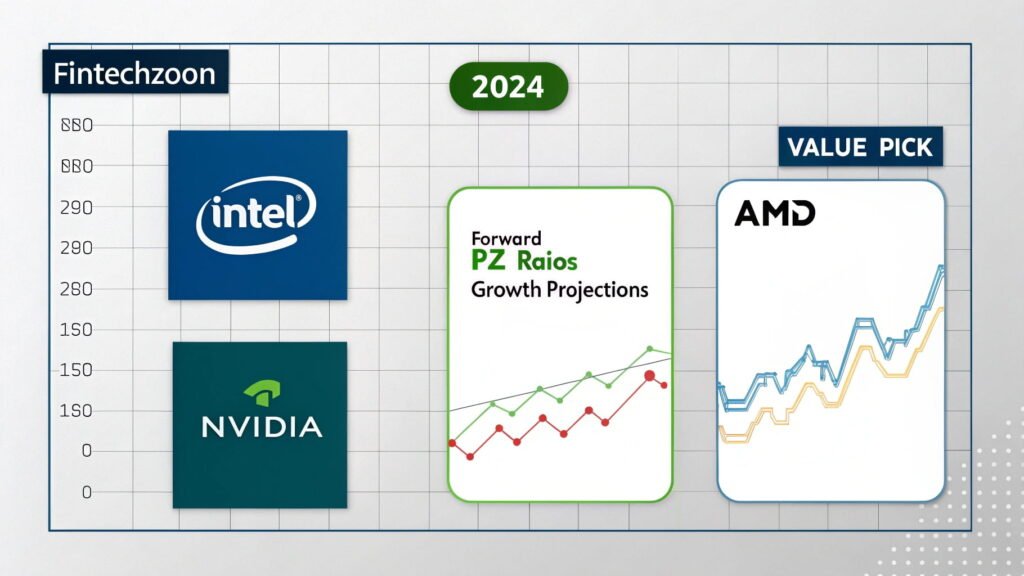FintechZoom Intel Stock: Insights, Trends & Forecast 2024!
FintechZoom Intel Stock offers real-time updates, expert insights, and detailed analysis of Intel’s market performance. It helps investors easily track trends, financials, and future potential. It is ideal for anyone looking to make smart, data-driven decisions on Intel shares.
Stay tuned — we’ll keep you updated on FintechZoom Intel Stock!
What Is FintechZoom and How Does It Analyse Intel Stock?
FintechZoom is a popular financial news website that shares updates on stocks, markets, and technology. Many investors visit FintechZoom to get the latest news and trends. When it comes to Intel stock, the platform looks at recent earnings, market moves, and expert views. The goal is to help readers understand how Intel is doing in the stock market.
The term Fintechzoom Intel stock has become popular among people who search for stock tips online. This is because FintechZoom often covers Intel and provides helpful insights. It breaks down the data so it’s easy to read, and charts, news stories, and analyst quotes are included. All of this helps readers make smart choices.
If you’re watching Intel stock, checking FintechZoom can give you a clear picture. It’s a simple way to stay informed.
Why Should Investors Trust FintechZoom’s Intel Stock Predictions in 2024?

Many investors follow FintechZoom because it provides clear and fast updates. Regarding Intel stock, FintechZoom looks at real numbers, company news, and expert opinions. It doesn’t just guess; it uses facts and trends. This makes its stock views helpful, especially in 2024, when markets are changing fast.
The term fintechzoom intel stock often appears in online searches. That’s because people want trusted info. FintechZoom checks earnings, growth plans, and tech news to help explain what’s next for Intel. It uses charts and clear data to back up what it says.
In 2024, with tech stocks on the move, many see FintechZoom’s Intel stock updates as a good guide for smart investing.
How Has Intel Stock Performed in 2024 and What Are the Key Drivers?
In 2024, Intel stock faced significant challenges, experiencing a substantial decline of over 60%. This downturn was attributed to various factors, including intensified competition from companies like AMD and NVIDIA and internal restructuring efforts. Despite these setbacks, there were notable developments. For instance, Intel’s introduction of new Xeon 6 processors to enhance AI capabilities marked a strategic move to regain market share. Additionally, appointing a new CEO brought renewed optimism, with some investors viewing it as a potential turning point for the company.
Platforms like FintechZoom have closely monitored these developments, providing detailed analyses and insights under the FintechZoom Intel stock. Their coverage has been instrumental for investors seeking to understand the complexities surrounding Intel’s performance in 2024.
What Key Financial Metrics Does FintechZoom Highlight for Intel Stock?
- Revenue Growth – Tracks how Intel’s sales are increasing over time.
- Profit Margins – Shows how efficiently Intel converts revenue into profit.
- Earnings Per Share (EPS) – Reflects the company’s profitability on a per-share basis.
- Return on Equity (ROE) – Measures how effectively Intel uses shareholder equity to generate profit.
- Forward Price-to-Earnings (P/E) Ratio – Indicates how the market values Intel’s expected future earnings.
- Overall Financial Health – FintechZoom Intel Stock analysis combines these metrics to provide a clear snapshot of Intel’s performance, helping investors make smarter decisions.
Is Intel Stock Undervalued in 2024?
In 2024, many investors believe that Intel stock is undervalued. Its price-to-book ratio is below 1, which means the stock trades for less than the value of the company’s assets. This suggests that the market may not fully recognise Intel’s real worth. Under the fintechzoom Intel stock section, this undervaluation is often highlighted, showing how Intel could be a hidden opportunity for long-term investors.
How Does Intel’s Valuation Compare to Rivals Like AMD and NVIDIA?

Intel trades at a much lower forward P/E ratio than rivals AMD and NVIDIA. AMD and NVIDIA have high valuations because of strong growth expectations, especially in the AI and data center space. But Intel has a more modest price, which may appeal to value investors. The fintechzoom Intel stock analysis looks at these differences to help readers decide which company offers better value for money in 2024.
Who Are Intel’s Main Competitors and How Is It Positioned Against AMD and NVIDIA?
AMD
- Gaining market share with Ryzen (consumer CPUs) and EPYC (server CPUs).
- Known for high-performance and energy-efficient processors.
- Strong competitor to Intel in both consumer and enterprise CPU markets.
NVIDIA
- Leads the GPU market, with about 88% of desktop graphics share.
- Dominates in AI and advanced graphics processing.
- A major threat to Intel’s ambitions in the AI and discrete GPU sectors.
Intel’s Position
- Introducing new products like Xeon 6 to target data centres and AI.
- Still lags behind AMD and NVIDIA in discrete GPUs and innovation.
- Faced ongoing pressure to catch up in performance and market share.
FintechZoom Intel Stock Insights
- FintechZoom provides up-to-date comparisons of Intel with AMD and NVIDIA.
- The fintechzoom Intel stock section helps investors assess Intel’s competitive edge and industry position.
What Industry Trends Like AI, 5G, and IoT Are Influencing Intel’s Future?
In 2024, Intel actively engages with major industry trends such as Artificial Intelligence (AI), 5G, and the Internet of Things (IoT) to shape its future trajectory. The company has introduced the Gaudi 3 AI accelerator, aiming to enhance enterprise AI capabilities and compete with existing market leaders. This move signifies Intel’s commitment to advancing AI technologies and integrating them into various sectors.
On the 5G front, Intel is collaborating with industry partners to develop robust 5G infrastructure, focusing on delivering high-speed connectivity and low-latency communication essential for modern applications. These efforts support the growing demand for real-time data processing and seamless connectivity.
In the realm of IoT, Intel is leveraging its hardware and software solutions to enable smarter devices and systems. The company aims to support the proliferation of connected devices across industries by focusing on edge computing and efficient data management.
Platforms like Fintechzoom provide comprehensive insights for investors seeking detailed analyses and updates on Intel’s involvement in these industry trends. The Fintechzoom Intel stock section evaluates Intel’s strategies and developments in AI, 5G, and IoT, assisting investors in making informed decisions in a rapidly evolving technological landscape.
What Are the Biggest Challenges Facing Intel in Today’s Market?
In 2024, Intel is navigating a complex landscape filled with significant challenges. One of the primary issues is the intense competition from rivals like AMD and NVIDIA, who have made substantial gains in market share, particularly in the CPU and AI chip sectors. Intel’s delays in manufacturing advancements and strategic missteps have allowed these competitors to outpace it in innovation and performance.
Financially, Intel has faced setbacks, including a notable decline in revenue and profitability. The company’s second-quarter 2024 earnings revealed a net income loss of $1.61 billion, starkly contrasting the $1.48 billion profit in the same quarter of the previous year. Additionally, supply chain constraints and a global slowdown in PC demand have further strained Intel’s operations.
Leadership changes have also contributed to the company’s challenges. CEO Pat Gelsinger’s departure in December 2024 highlighted internal struggles and the need for a strategic overhaul. Furthermore, Intel’s ambitious IDM 2.0 strategy, aimed at revamping its manufacturing capabilities, has yet to yield the desired results, adding to investor concerns.
Platforms like Fintechzoom offer comprehensive insights for those seeking in-depth analyses and updates on Intel’s market position. The Fintechzoom Intel stock section provides evaluations of Intel’s performance, strategic initiatives, and hurdles, assisting investors in making informed decisions in a rapidly evolving tech industry.
How Accurate and Useful Is FintechZoom for Real-Time Intel Stock Tracking?
- Real-Time Updates – FintechZoom provides up-to-the-minute Intel stock prices and market trends.
- User-Friendly Charts – Easy-to-read visuals help track performance and understand market shifts.
- Detailed News Feed – Get relevant news that explains how current events affect Intel’s stock.
- Essential Metrics – The fintechzoom intel stock section covers price changes, trading volume, and historical performance.
- Useful for All Investors – Suitable for both day traders and long-term investors.
- High Reliability – While no tool is perfect, FintechZoom is praised for its accuracy and timely updates in stock tracking.
What Does FastBull Say About Intel Stock’s Long-Term Potential?

- Positive Leadership Outlook—FastBull sees Lip-Bu Tan’s appointment as a strategic win due to his venture capital and tech experience.
- Focus on Restructuring – His leadership may support Intel’s restructuring and market repositioning.
- Growth in Key Areas – Intel is expected to strengthen its hold in the enterprise PC and server CPU markets.
- Strategic Partnerships – Analysts suggest potential foundry partnerships could improve Intel’s long-term financial health.
- FintechZoom Intel Stock Insights—The FintechZoom Intel stock section complements FastBull’s views with real-time updates and strategic evaluations to guide investors.
Is Intel a Good Long-Term Investment in 2024, According to FintechZoom and Experts?
Intel Corporation (NASDAQ: INTC) has faced significant challenges in 2024, including intensified competition from AMD and NVIDIA, delays in manufacturing advancements, and strategic missteps. These issues have led to a decline in market share and stock value, with the company reporting a net income loss of $1.61 billion in Q2 2024.
Despite these setbacks, Intel remains a financially sound company with a strong balance sheet. In 2024, Intel’s revenue reached $80 billion, with its data centre segment contributing significantly to growth. The company also announced a $10 billion stock buyback program, showcasing its confidence in the long-term value of its shares. Intel’s dividend yield of around 3.5% remains attractive for income investors.
FintechZoom highlights Intel’s efforts to shift toward high-growth areas such as data centres and artificial intelligence (AI), which have started showing promising recovery signs. The company’s upcoming Meteor Lake processors, set to launch in 2025, are expected to feature advanced architecture and AI integration designed to outperform current-generation chips.
Analysts suggest that while Intel’s short-term outlook remains challenging, its long-term prospects could improve if the company successfully executes its IDM 2.0 strategy, ramps manufacturing capabilities, and delivers cutting-edge products. Investors willing to take a long-term view may find Intel an attractive addition to their portfolios.
For those seeking detailed analyses and updates on Intel’s position in the market, platforms like FintechZoom offer comprehensive insights. The Fintechzoom Intel stock section provides evaluations of Intel’s performance, strategic initiatives, and hurdles, assisting investors in making informed decisions in a rapidly evolving tech industry.
FAQ’s
1. What makes FintechZoom a reliable source for Intel stock analysis?
FintechZoom stands out for its real-time updates, detailed market reports, and easy-to-understand charts. For Intel stock, it offers deep insights into price movements, expert opinions, and financial performance, helping investors make informed decisions.
2. How does FintechZoom track Intel stock differently from other financial platforms?
Unlike many general finance sites, FintechZoom focuses heavily on stock sentiment and trend analysis. Its Intel stock section includes performance breakdowns, news impacts, and expert commentary tailored for retail investors.
3. Can beginners use FintechZoom to understand Intel stock trends?
Yes, FintechZoom is user-friendly and designed to help even first-time investors. It simplifies technical data and financial metrics, making Intel stock trends easier to follow and act upon.
4. Does FintechZoom provide future projections for Intel stock?
FintechZoom regularly publishes outlooks and predictions based on market analysis, earnings reports, and industry trends. These projections help users evaluate whether Intel stock fits their long-term investment strategy.
5. Is FintechZoom free to use to track Intel stock?
Yes, most of FintechZoom’s Intel stock tracking features are free. Users can view charts, read expert analysis, and monitor real-time data without a subscription.
Conclusion
The investing world moves fast, and having the right tools makes all the difference. For those tracking Intel stock, FintechZoom offers a powerful combination of real-time data, expert analysis, and market sentiment insights—all in one place. Whether you’re a long-term investor or simply exploring opportunities in the tech sector, the fintechzoom intel stock coverage helps you stay informed and confident in your decisions.
In 2024, Intel faces challenges but also shows strong signs of potential through its innovation in AI, data centres, and chip manufacturing. Platforms like FintechZoom give you an edge by making these updates accessible and easily understood. So if you’re considering Intel as part of your investment strategy, using FintechZoom could be a smart move to stay ahead in a competitive market.














Post Comment